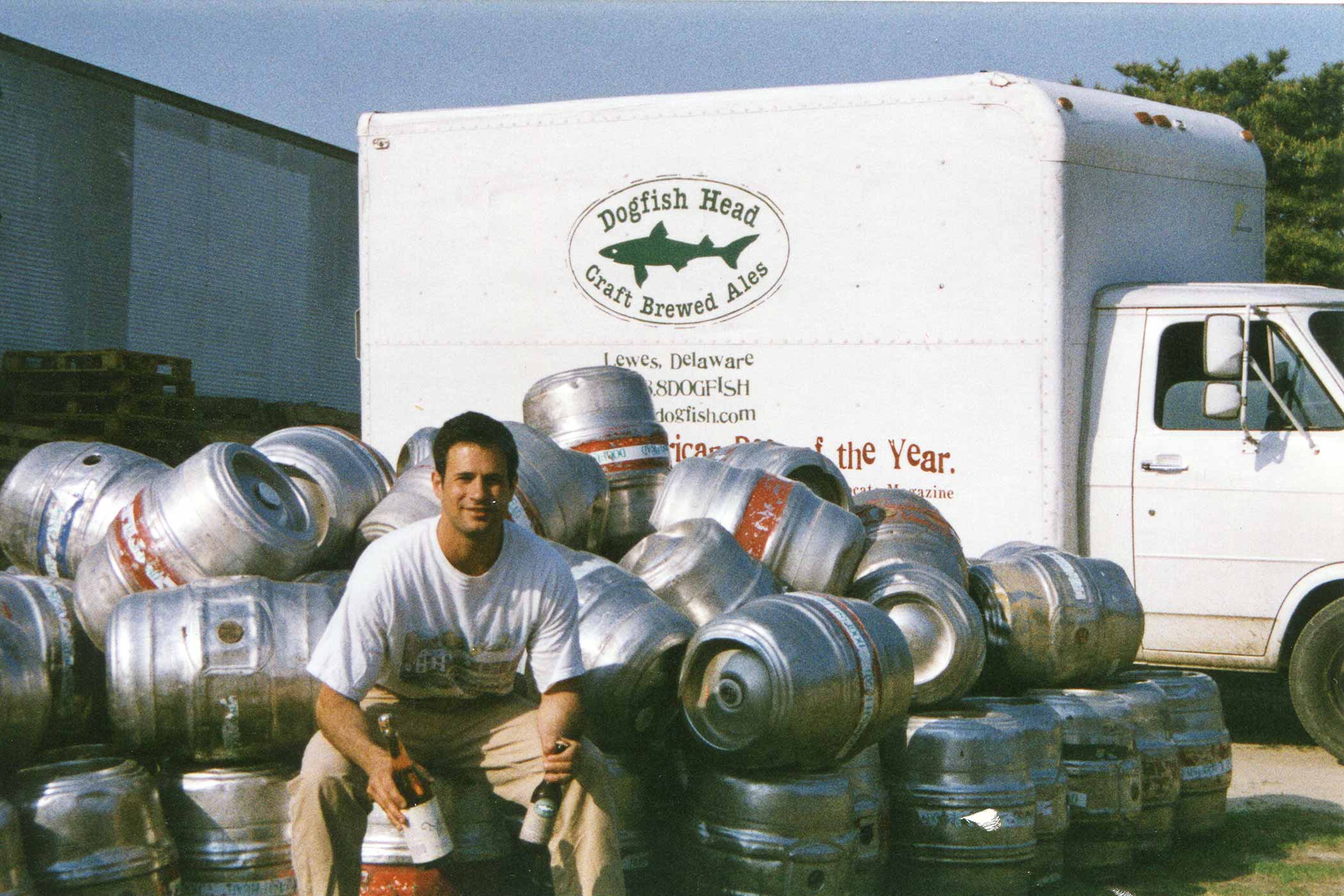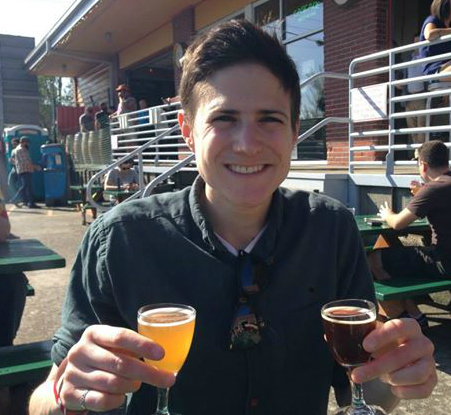Shop
America’s Next Great Novel: The 30-Year Story of Dogfish Head
Off-centered goodness for off-centered people.
Like This, Read That
This isn’t an introduction to the next great American novel, but it could be the first page.
It’s a party. Just not one that we’ve ever been to. Look around the room and you’ll see now-familiar faces—future comedians, big-time actors, talk show hosts, and one brewery owner.
As people sip on his homebrewed cherry pale ale, a twenty-something-year-old Sam Calagione stands up.
Perhaps fueled by a bit too much of his own ale and buoyed by his new homebrewing hobby, he publicly declares that he wants to start a brewery.
It’s the early nineties in New York City. In a five-floor walk-up full of creative talent, the guy from Massachusetts who always imagined he’d be the next Jack Kerouac has just changed the course of his life forever.
This is the beginning of Dogfish Head.
Opened in 1995 in Rehoboth Beach, DE, this tiny brewpub became the first in the First State and the smallest commercial brewery in the U.S. at the time.
Thirty years later, I’m Zooming with Sam while he’s staying at his place in the Dogfish Head area of Maine. He’s just gotten back from a boat tour, attending events to celebrate the brewery’s three-decade anniversary.
Tonight, he’ll go to a fundraiser where he’ll crack his first can of Cherry Pale Ale, which the brewery has remade for the first time. They hope to pay homage to the humble beginnings of one of America’s most iconic breweries.
“I haven’t even had a sip yet,” he shares with me. It’ll be the first time he’s drunk this beer since making a drunken declaration.
Could the creative storyteller ever imagine he’d be reflecting on thirty years of beer history?
“Not at all, no!” he tells me emphatically, noting the one-barrel R&D brewery he has in his Maine cabin is bigger than what he started with at Dogfish Head.
But isn’t that just the thing with ingenious inventions written on the back of napkins or remarkable American manuscripts penned in dusty corners of modest houses? They’re brilliant because their future isn’t written yet.
Only years later, when we recount their beginnings, do we truly understand their greatness.
This is Dogfish Head’s history, a story of the next great American brewery.
Chapter One: From New England Basement Beer Fridges to New York Apartment Parties
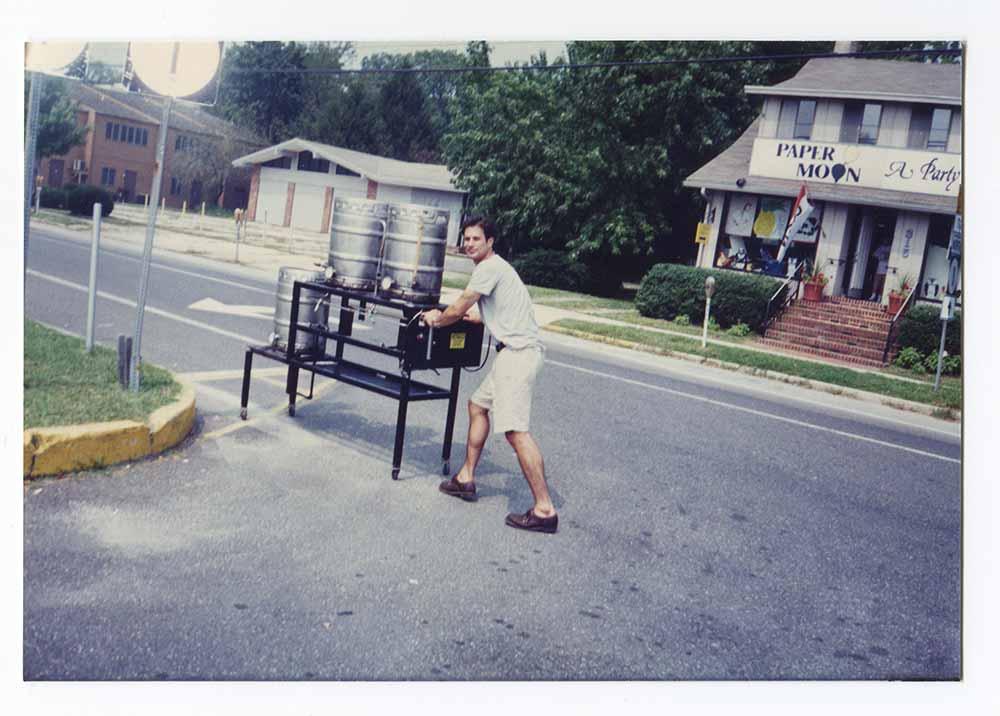
Photography courtesy of Dogfish Head
Sam credits his dad for introducing him to beer, whether he knew it or not.
“I would steal from his beer fridge in high school,” laughs the grizzled brewery owner, who remembers reaching for Anchor, Moosehead, and even the occasional “Sam Lager.”
In college, things went downhill. “I drank the sh**tiest, cheapest beer we could find,” says Sam.
But everything changed the summer after graduating. Sam moved to New York City to become a creative writer, hoping to enroll in Columbia’s MFA program.
He moved into an apartment with a friend he’d made during a study abroad program in Australia.
Joe DeLuca was from Long Island. He and Sam hit it off right away. “It was this weird kismet,” remembers Sam. “He said, I have some guys we can room with. They’re f**king hilarious; you’re going to love them.”
Those “guys” were Ken Marino and Joe Lo Truglio.
Marino became an American actor, known for his roles in Party Down, Marry Me, Burning Love, and Childrens Hospital
Lo Truglio, perhaps best known now for his role as NYPD detective Charles Boyle on the sitcom Brooklyn Nine-Nine, started his career with the NYU-based sketch comedy troupe The State.
In the early nineties, MTV gave the group the green light to do an eponymous show, which ran for three years.
They often practiced in Sam’s five-floor walk-up in Chelsea. Sounds glamorous today, but back then, Chelsea wasn’t yet a “cool” neighborhood, he cautions wryly. “We had the biggest, albeit sh**tiest, apartment!”
While the troupe practiced in the living room, Sam hand-capped homebrews in the corner, a hobby he’d picked up while working to make ends meet at a first-gen craft beer bar on the Upper West Side.
Nacho Mama’s Burritos may not sound like a place to get a quality pint, but it was. Within a few weeks, Sam’s shifties (free beer given after each shift) became Chimay Red, Rodenbach, Brooklyn Lager, Samuel Adams Summer Ale, and Celebration (when it was available).
The bar’s owner, Joshua Mandel, who was just a few years older than Sam, loved beer. So before long, the pair decided to give homebrewing a try.
“We went to Little Shop of Hops, the one shop in Manhattan that sold brewing ingredients,” says Sam, who walked out with an English pale ale brewing kit, some plastic jugs, and cappers.
Mandel headed back up to the Upper West Side, and Sam headed down to Chelsea. While walking home, Sam passed a bodega and noticed a pile of food with a cloud of fruit flies above it. “The sign said, ‘Cherries Half Price,’” he remembers.
The budding brewer thought the stone fruit would complement the fruitiness of the Cascade hops in his hand.
Already, this off-centered person was thinking about off-centered goodness.
Cherry Pale Ale became the first beer Sam ever made.
Without any knowledge of what to do beyond the instructions in the kit, Sam instinctively added his “squishy pile of cherries” to the end of the boil.
He mashed in the cherry juice and plopped the skins and all into the plastic jug he’d just bought to ferment. “It was wonderfully intense,” he reminisces.
Sam calls that first homebrew, Cherry Pale Ale, lucky.
During that apartment party with Marino, Lo Truglio, Ricki Lake, and a few others, Sam stood up and declared to everyone that he wanted to open a brewery.
“My next two batches of homebrew sucked,” laughs Sam. But since he’d already declared his dream, he “couldn’t back down.”
Waking up the next morning with a hangover, Sam walked to the New York City Public Library and used LexisNexis to research small artisanal businesses.
From that point on, the plucky pioneer put down his pen and picked up his plastic jugs.
“Instead of trying to write the great American novel,” muses Calagione, “I wrote a business plan.”
Chapter Two: The Next Great American Brewery in America’s First State

Photography courtesy of Dogfish Head
Sam grew up in Western Massachusetts. It’s where he met his wife and eventual business partner, Mariah Calagione. She was a boarding student from Delaware. Sam was a local.
They met working in the kitchen of the dining hall during Sam’s junior year and Mariah’s sophomore year. The high school sweethearts have been together ever since.
During the summers, Sam went up to Maine, where his parents owned a vacation home in what’s referred to as Dogfish Head.
The area gets its name from a local shark, called a dogfish, common in the surrounding waters.
If you look at a map, the peninsula also supposedly looks like a dogfish, the outline of which Sam designed as the logo we’ve all come to know.
The area means something to Sam, who kept going back even in his early twenties.
After the infamous party, while visiting his parents’ place on Pratts Island in Southport, he went for a jog with his dad.
Mariah actually shared this story with me. When Sam’s dad asked how his writing classes were going, “He said, I’ve changed course,” recounts Mariah. “Instead of becoming a writer, I want to open a brewery.”
As the pair kept running, Sam’s dad pointed to a Dogfish Head street sign and said, “That would be a good name for a brewery.”
With all these ties to Maine, it begs the question: How did Dogfish Head end up in Delaware?
Although Sam originally wanted to open Dogfish Head in New England, by the time he finished raising the $220k needed to build a brewery, the area had enough craft breweries.
“I looked in concentric circles from where I grew up,” explains Sam. “What’s the first state closest to us that didn’t yet have a commercial brewery?”
Somewhat ironically, the First State—Delaware.
Mariah grew up in Delaware. She and Sam spent college summers renting houses on Delaware Beach. At the same time, Mariah’s dad called to say that plans for a brew pub in Rehoboth Beach had fallen through.
“I supported it,” shares Mariah, who had said she’d never move back to her home state, “but I didn’t want to be blamed for dragging him to Delaware.”
Far from dragging, Sam felt the decision was again “kismet.”
Located close to Philadelphia, Baltimore, and New York City, Rehoboth Beach was a central location for distribution. And close to home, during the summers, people packed the beach town.
The state itself proved friendly to business, although with a caveat.
While preparing to open the brewery, Sam ran into an unforeseen hurdle. He vividly remembers one day early on, while he worked on putting up Dogfish Head’s new sign. “Literally the first person who walked by went, ‘You know it’s illegal to open a brewery in Delaware?” he laughs.
Undeterred, the intrepid entrepreneur hopped in his car and drove down to the capital.
“I started knocking on doors,” he says. Within a week, he had written a bill and proposed it on the Senate floor. “It was a surprise to everyone that we got it done.”
Mariah says over Dogfish Head’s thirty-year history, they’ve spearheaded somewhere between twelve and sixteen changes to the law, including allowing for distilleries, growlers, and off-premise sales on Sunday.
Where one might have seen defeat, Sam saw opportunity.
It’s an attitude he would need often throughout Dogfish Head’s early days.
Chapter Three: No Plan, Some Money, No Problem
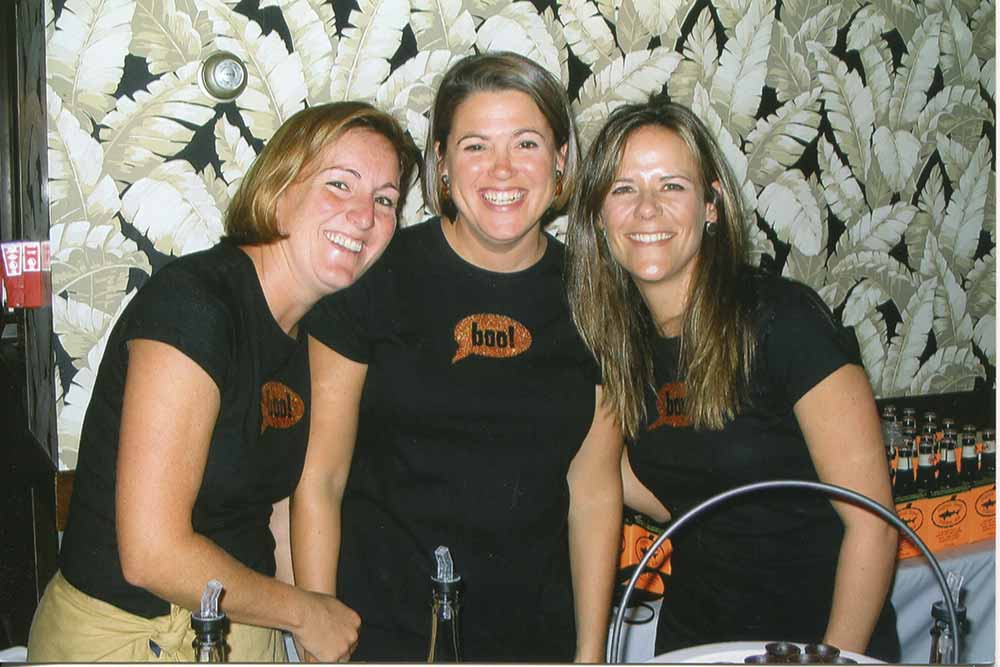
Photography courtesy of Dogfish Head
“It was like the Wild West,” says Dogfish Head’s longest-tenured brewer, Bryan Selders, who has briefly joined our conversation.
Selders, who has been brewing at Dogfish Head for twenty-three years, has joined Sam and Mariah at their cabin in Maine to celebrate some events around the thirty-year anniversary.
“Our original production facility was cobbled together from all sorts of sh*t,” he continues.
Dairy equipment, clarifies Sam. “There was no new equipment in the whole building.”
Dogfish Head operated on a tight budget during those early days. “We tried to do it, I won’t say on the cheap,” says Mariah, “but it was on the cheap!”
The English and public policy majors had never hired anyone, they’d never done payroll, they didn’t know what the words “cash flow analysis” meant, and they’d certainly never owned a business. Although they had worked in many.
At the time, Mariah says the couple in their mid-twenties were pretty carefree. “We didn’t have a house, we had a used car, we didn’t have kids,” she says. “We had nothing at all, but we also had nothing to lose.”
Perhaps it’s that lack of fear of jumping with no rope, no fishing net to catch them, that drove Dogfish Head forward. They opened during a summer in Delaware, one of the busiest times of the year.
“It was craziness right out of the gate,” admits Mariah, who kept her day job at a local TV station for the first two years. Sam jokes, “So that we could have health insurance!”
But on the weekends, Mariah would do everything from bussing tables to painting chairs. “It was 24/7,” she says. “But it was a lot of fun.”
Sam’s family came down to lend a hand. Co-workers became friends. And when a band came into town to play a set at the brewpub, “they stayed at our house,” says Mariah, who joined full-time two years later.
If Wain and Michael Showalter wrote a PG version of Wet Hot American Summer (and yes, for those following along this Marino starred in this movie as well), we imagine that might have been the beginning months of Dogfish Head.
“We faked it until we made it,” laughs Mariah, who says watching Sam hand-bottle in the walk-in while wearing a garbage bag because beer sprayed everywhere didn’t make her think, “Oh, this is really going somewhere.”
But once Dogfish Head started distributing beer and began reaching more people, it did go somewhere; somewhere neither of the two high school sweethearts ever thought possible.
After all, no one had ever seen a brewery quite like it. A brewery not focused on nailing the classics of brewing, but one nailing convention to the wall.
Chapter Four: A Sprinkle of Self-Reliance, A Dash of Bravery, A Pinch of Stupidity
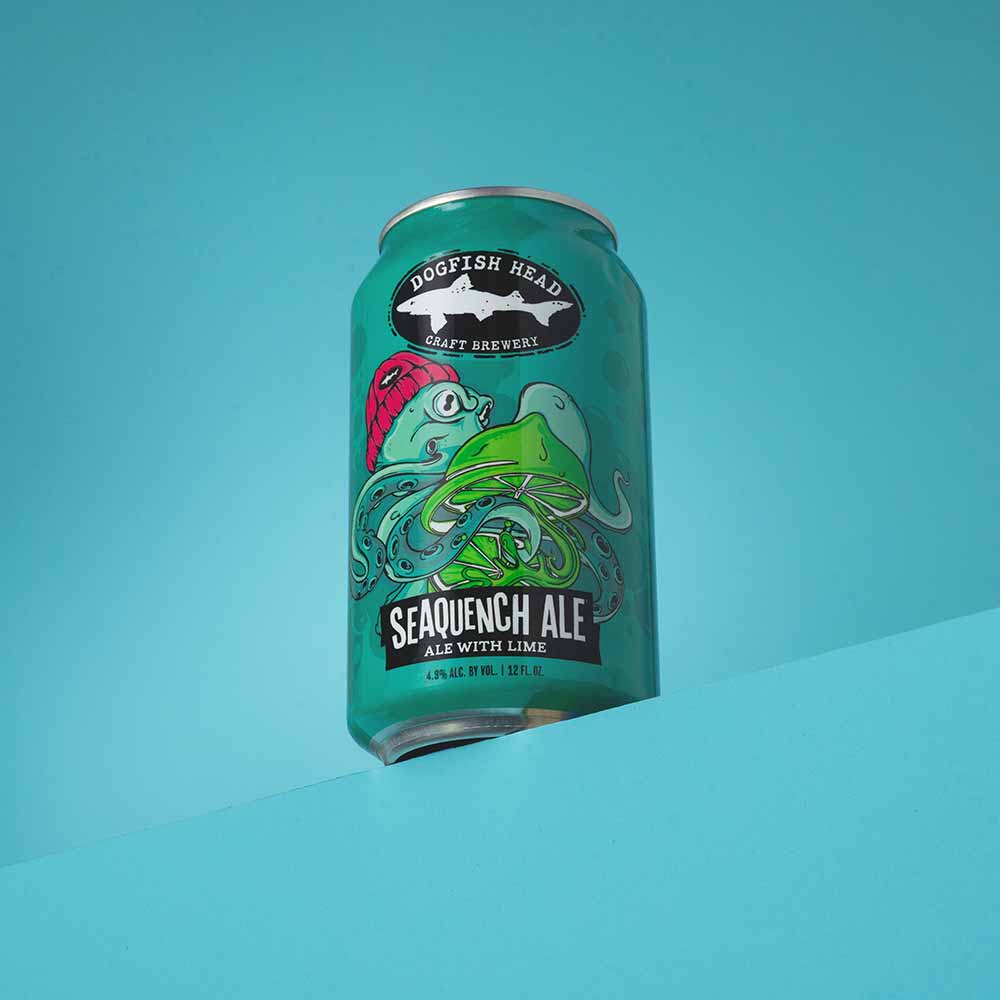
Photography courtesy of Dogfish Head
If you know Dogfish Head, then you probably know its motto: Off-Centered Goodness for Off-Centered People.
Inspired by a Ralph Waldo Emerson quote* from Self-Reliance, Calagione wrote his business plan with a commitment to brewing the majority of his beers outside the Reinheitsgebot (German purity law that says beer can only be made from four ingredients—water, barley, hops, and yeast). Instead, he wanted to use culinary ingredients to influence his recipes.
“I’m really proud of that statement,” says Calagione, who notes it’s still true today.
Dogfish Head opened with four beers, Shelter Pale Ale (the only Reinheitsgobot beer they did, according to Sam); Chicory Stout, made with chicory, Mexican coffee, and a bit of licorice root; Boothbay barleywine (which later became Immort Ale) with peat-smoked barley, maple syrup, and vanilla beans; and Indian Brown, a black IPA (“before there was a term for it,” says Sam) with flaked maize.
Today, if you visit Dogfish Head’s big Milton brewery, “You’ll see these 1,200-barrel massive tanks [that might have] sea salt and black limes or cinnamon and brown sugar or granola and Kernza,” says Sam, referencing the brewery’s SeaQuench, Punkin Ale, and newly released Grateful Dead Juicy Pale Ale.
Everything Dogfish Head makes or does filters through this tagline.
“It’s a movable feast,” explains Sam, “an exploration of goodness.”
And also a rallying cry. Every decision Dogfish Head makes has to pass this litmus test. “Is it off-centered?” says Sam.
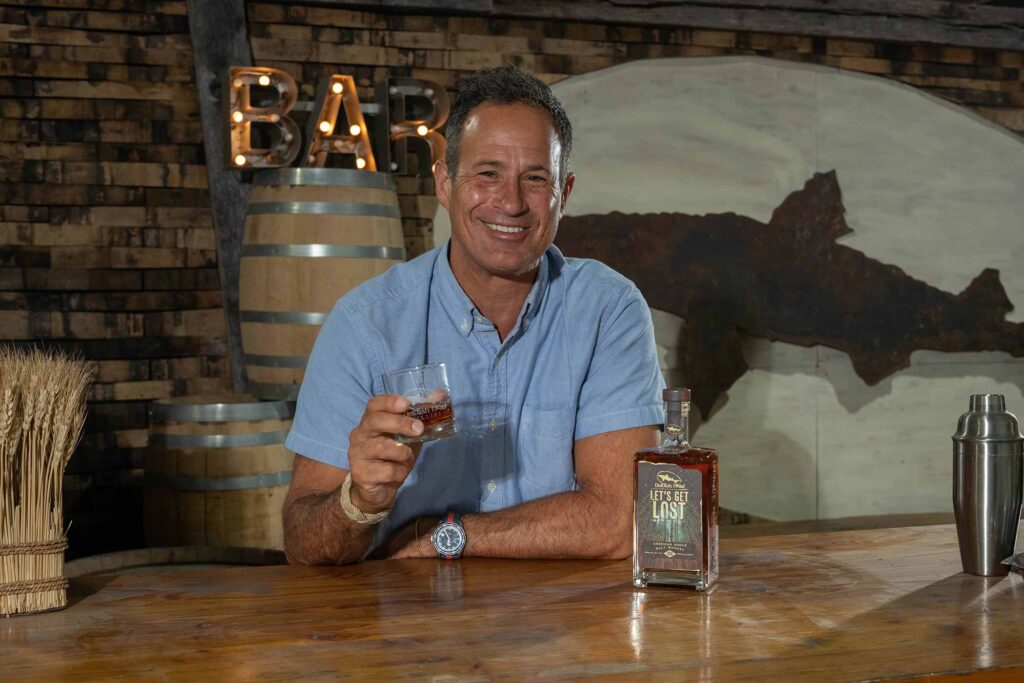
Photography courtesy of Dogfish Head
For example, should Dogfish Head start a distillery? Only if they bring unexpected ingredients into the spirits world, infusing rum with honey from apiaries just miles from the brewery, or gin not just with juniper but hop leaves and exotic fruit peels.
And today, “Off-Centered Goodness” doesn’t apply just to beer.
In its thirty-year history, Dogfish Head has opened the first beer-themed hotel in America and collabed with companies like Merrill Shoes and New Balance. They’ve started wacky events like the Weekend of Compelling Ales & Spirits and Analog-A-Go-Go. “Those are unexpected places to create new products for a traditional brewery,” says Sam.
And it all comes back to the phrase: “Off-Centered Goodness for Off-Centered People.”
*Editor’s Note: This is the Ralph Waldo Emerson quote we’re referring to in its entirety: “Whoso would be a man, must be a nonconformist. He who would gather immortal palms must not be hindered by the name of goodness but must explore if it be goodness. Nothing is at last sacred but the integrity of your own mind.”
Chapter Five: Thirty Years of Beers: Football Games, Middle Fingers, and Fine Red Wines
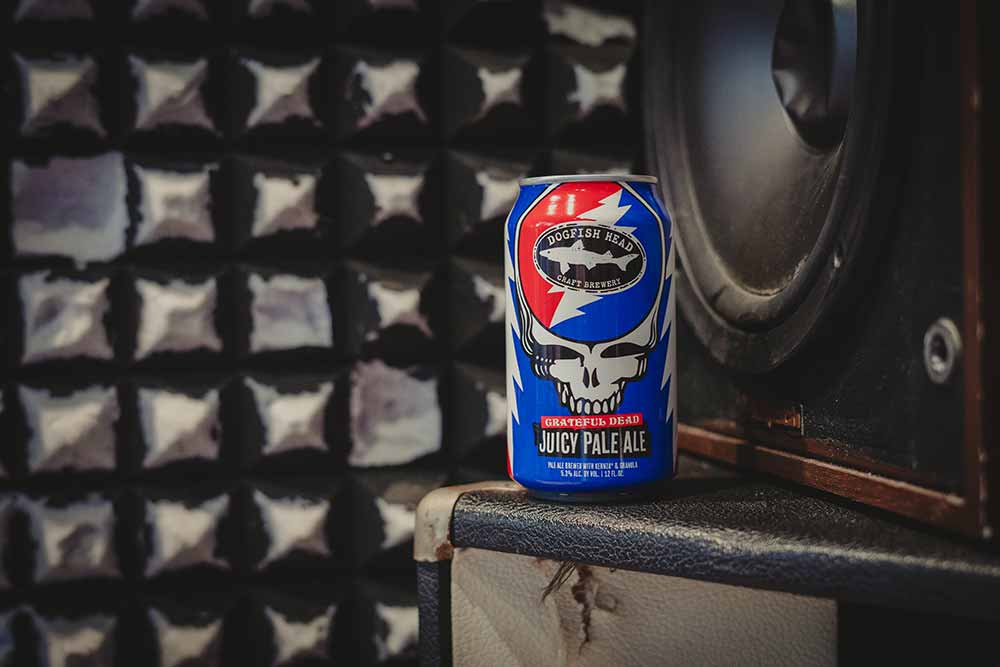
Photography courtesy of Dogfish Head
What is your favorite Dogfish Head beer? With 1,312 beers listed on Untappd and three decades worth of iconography, the Dogfish Head Co-Founders should have trouble answering this question.
But for Sam, “That’s actually an easy one,” he tells me. “They’re the two I drink the most.”
The recently released Grateful Dead Juicy Pale Ale (which I drank for inspiration while writing this article) has become Dogfish Head’s fastest-growing beer in the history of the company, even compared to 60-Minute IPA (more on that later).
Made with granola and Kernza, the juicy pale ale certainly passes Dogfish Head’s litmus test.
“It’s dry, refreshing, and super poundable,” says Sam. “It works really well for multi-pint nights.”
For his other choice, Sam chooses what he calls “both a high five and a middle finger to the Reinheitsgebot.”
A sequential merging of three German styles—kölsch, Berliner weisse, and gose—SeaQuench also includes sea salt and black limes.
Brewed for the 500th anniversary of the German purity law, this salty, tangy, low-ABV ale quickly became one of Sam’s all-time favorites because it reflects Dogfish’s passion for culinary experimentation and defying convention.
“It’s much more complicated than people understand,” Mariah says of the easy-drinking session sour mash-up. “But for people who have never had it or aren’t big beer drinkers, they’ll try this and go, ‘Oh my god, this is so good!’”
For Mariah, Festina Pêche will always hold a special place in her heart. But she admits that she still drinks a lot of 60 Minute IPA, calling it an “old standby.” This summer, the Grateful Dead Juicy Pale Ale has been high in the rotation, too.
For us, it’s hard to mention Dogfish Head in the same sentence without Raison D’Être, a Belgian strong dark ale with beet sugar and green raisins that Sam added to the rotation a year after opening. The beer that developed a cult-like following recently made its way back to shelves in a throwback variety pack this year.
Or 60 Minute or 90 Minute IPA, which became two of the most iconic beers in American craft beer.
After watching a cooking show where a chef sprinkled tiny pinches of cracked pepper into the barely boiling broth, Sam wanted to find a similar way to “continually season” his wort with hops.
Since nothing existed, Calagione had to build something from scratch.
In a Salvation Army store out by the highway, “where I used to get my flannel shirts,” Sam once told us, “I remembered seeing a 1960s- or ‘70s-era vibrating football game on the shelf with other dusty Monopoly boards and outdated stereo equipment.”
Sam bought the game and, that very same day, took a drill, punching out different-circumference holes and duct-taping a bucket on two-by-fours to the game in a way that left the playing field like an open runway.
“I put it on a step ladder over the boil kettle of my five-barrel brewing system,” Sam explains. “Just by changing the angle of the football game, I could figure out the right angle that the hop pellets would vibrate out of the bucket, down the football [field], and into the boiling beer.”
“The first time we brewed it, we were like, holy shit, this really works!” remembers Sam. “When you continually hop a beer with little doses the whole time, you can make a beer that’s magnificently hoppy and pungent with beautiful hop aromatics.”
Hence the name: 90 Minute IPA, a beer continually hopped for the entire 90-minute boil, at 9% alcohol, and 90 IBUs.
Today, you can even find Sam’s invention in the Smithsonian next to the Wright Brothers’ planes, Apollo rockets, and Betty Crocker’s Kitchen.
Sam says he got pretty lucky, nailing what he wanted to do on the first try.
Wait, haven’t we heard this before? Isn’t this exactly what happened with Cherry Pale Ale?
Chapter Six: Getting Merry With Cherry
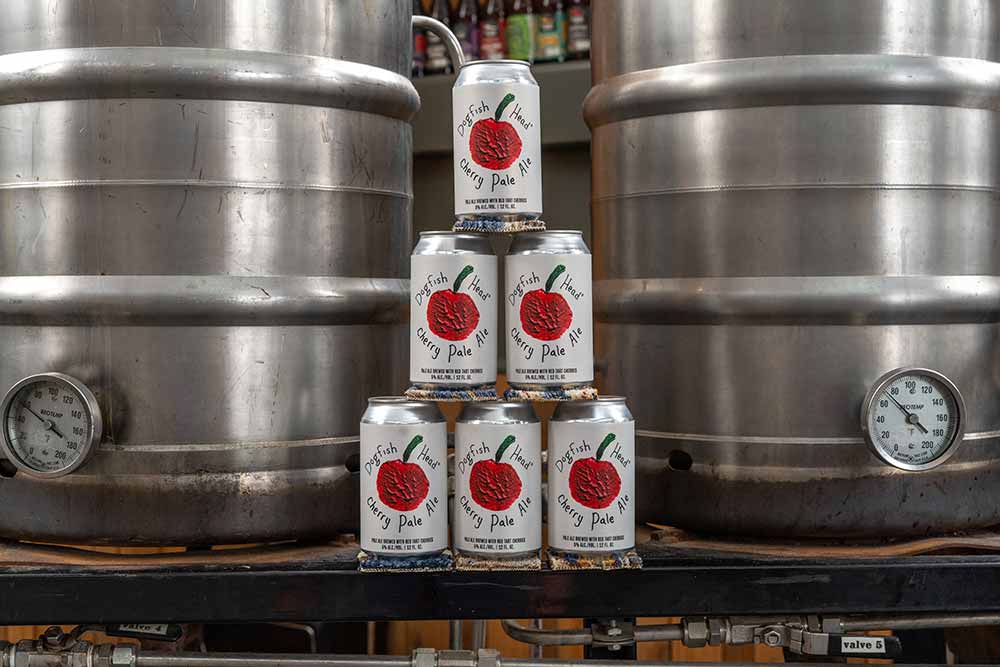
Photography courtesy of Dogfish Head
To celebrate Dogfish Head’s thirty-year milestone, the brewery will be releasing Sam’s now-iconic first-ever homebrew, Cherry Pale Ale, on a commercial scale.
Dogfish Head’s longest-tenured brewer, Selders, spearheaded the halcyon project, which needed a few updates to go to market.
Selders politely describes Sam’s first attempt as an extract recipe.
“The malt was extract,” interjects Sam, “but the cherries were real!”
No extract here, as Selders opts for a grist with a nice amount of Crystal 60, Munich, and honey malt “to build some good roundness that was characteristic of East Coast pale ales at the time.”
Trying to stick to that profile, Selders incorporates Cascade, because it was the most widely available hop at the time, and a Chico ale yeast.
Sam confirms his original recipe included Cascade, too.
For the cherries, Selders forgoes the squishy bodega pile Sam found for a combination of black and red tart cherry purée and cherry juice, which he adds towards the end of active fermentation.
For a nostalgic touch, a bunch of co-workers sat down and hand-cut and glued coasters to the cans.
The “carpet coaster” refers to Sam’s first homebrew batch. Unaware yet of sterilizing cleaners, Sam baked all his glass bottles in their apartment oven (something he’d read in an old homebrewing book). When he took the hot bottles out, he set them on the floor. “They burned their way into the rug,” laughs Sam, who had to cut them out with an X-Acto knife. “Obviously, we did not get back our deposit on the apartment.”
Chapter Seven: Family…Friends…Dogfish
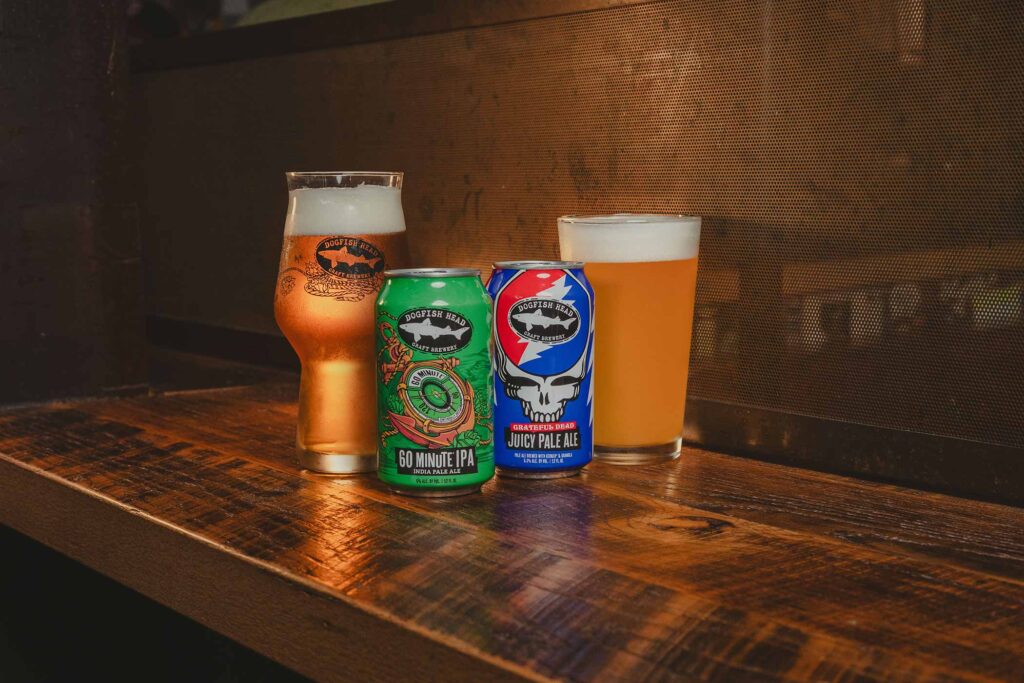
Photography courtesy of Dogfish Head
When I give Sam and Mariah the impossible task of reflecting on this three-decade milestone, they share the same answer.
Beyond the beer, superior to the success, Dogfish Head’s ultimate achievement has been its people and the people it’s inspired.
Those like Selders, who joined Dogfish Head in 2002. He still remembers getting the call from Sam during that year’s Super Bowl. He speaks of the conversation like a player switching teams.
“He called me while driving over the George Washington Bridge,” Selders recalls perfectly. “I later found out that I’d been traded for a case of Worldwide Stout.”
Sam jumps in explaining that he knew Selders’ boss would be unhappy that he was poaching his brewer, “so I proactively sweetened the deal.”
Selders is just one example of the family Dogfish Head fostered.
Sam will be the first to admit that he isn’t a technical brewer. The former creative writer calls himself a theoretical brewer and storyteller first.
So he hired people with “superpowers” above his own, who have all contributed to Dogfish Head’s adventure.
Mariah says it’s most meaningful to her to go to any restaurant in coastal Delaware and see at least one former co-worker.
Or to hear stories of people who got engaged at the brewery or came to Milton just to visit Dogfish Head.
“The craziest is when someone says, ‘Do you want to see my Dogfish tattoo?’” Mariah laughs, showing off her own Dogfish Head logo inked on her upper left arm. Sam got his first to celebrate the brewery’s twentieth anniversary in 2015. Mariah’s is fresh, just from last September. Whereas Sam designed his to have a weathered feel, Mariah’s is plain black. She says it still stuns her to see others get one, though. “They have it on their body forever!”
But that in and of itself is always a story.
And somewhat poetically captures Dogfish Head, whose beers have impacted people enough for them to make a permanent declaration.
Sound familiar, Sam!?
“More than the awesome beverages we’ve made, our continual hopping machine that’s in the Smithsonian, or getting a James Beard award,” says Sam, “I’m thinking about expressing myself creatively everyday, doing this with my wife, and all the amazing people who joined us on this journey and made Dogfish bigger and better than I ever dreamed.”
You can’t look at Dogfish Head’s thirty years without feeling like you’re reading a book. Flip through the pages, and you’ll see a guy standing up in a Chelsea apartment, a couple of high school sweethearts moving to Delaware with a dream, fermentation tanks stuffed with sea salt and black limes, green raisins, and granola and Kernza, and a jerry-rigged football game that’s now in the Smithsonian.
Sam may think that, thirty years ago in New York City, he abandoned his dream to write the next great American novel.
We think, with Dogfish Head, he’s still writing it.
This piece is written in partnership with our friends at Dogfish Head.

